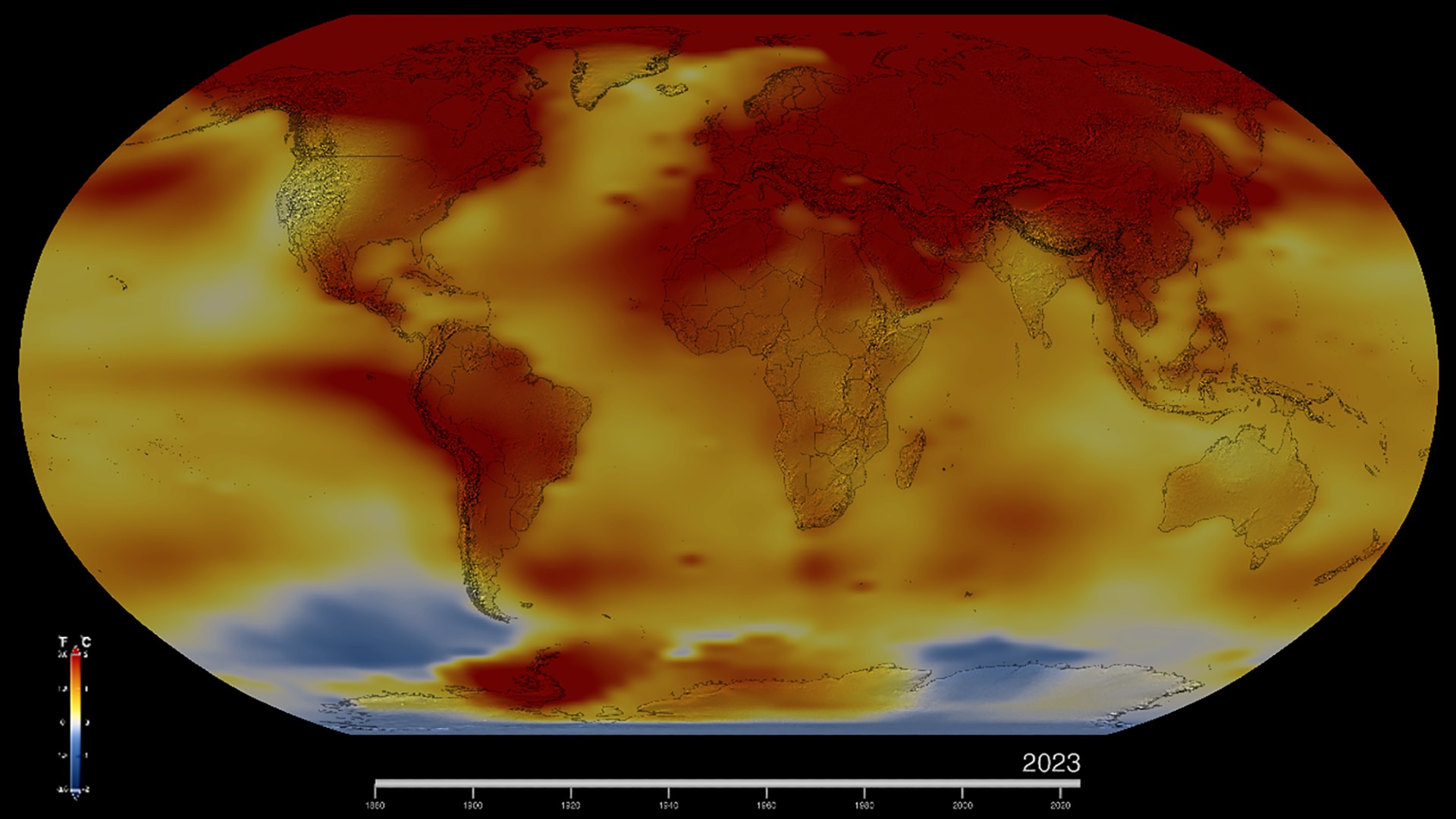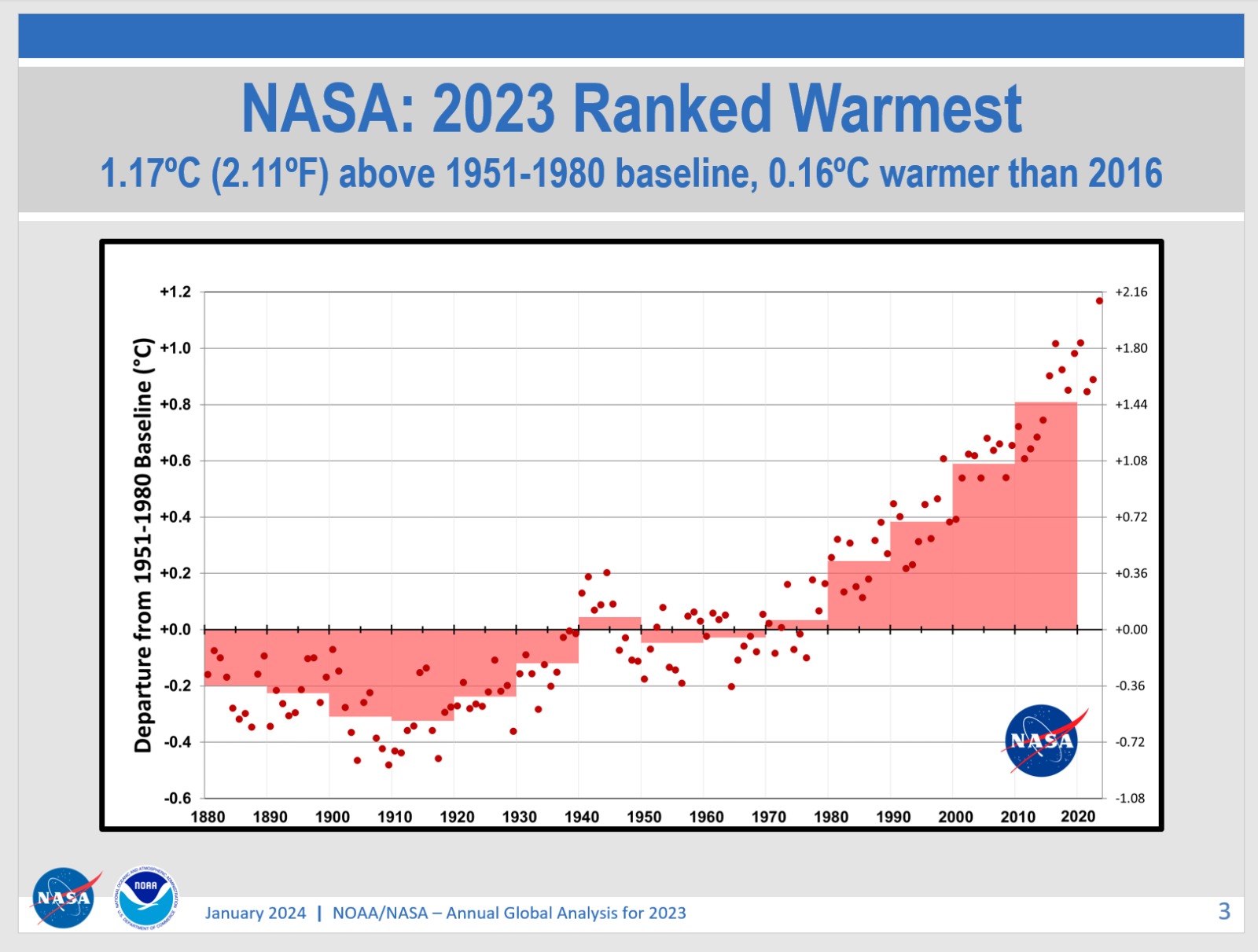2023 was the hottest year on record, NASA and NOAA say
"The findings are astounding."
It's official: 2023 was the hottest year on record.
On Friday (Jan. 12), climate scientists from NASA and NOAA unveiled data showing that temperatures continue to rise at shocking rates, contributing to severe climate-driven weather events worldwide. NOAA's and NASA's analyses did not use satellite data or weather forecasts. Instead, their analysis used surface data that included sea surface temperatures measured by ships and buoys and air temperatures collected by terrestrial weather stations to track climate change.
What those analyses found has scientists shocked. "The findings are astounding," said Sarah Kapnick, chief scientist at NOAA. "2023 was an extraordinarily warm year that produced many costly climate driven weather events here in the United States and worldwide."
Gavin Schmidt, director, NASA's Goddard Institute for Space Studies, added that the different in average temperatures by which 2023 beat previous record years of 2016 and 2020 is well above estimates of measurement uncertainty, making scientists confident in declaring 2023 as the hottest year on record. "None of those uncertainties are large enough to change the bottom line of what we're talking about," Schmidt added." And that that's the long term trend and the record walks that we're seeing in 2023.
"And so, we're looking at this and we're frankly, astonished."
Related: 10 devastating signs of climate change we see from space

Schmidt added that the record temperatures are in line with the agency's predictions for how changes in greenhouse gases and other forces would impact global temperatures.
Breaking space news, the latest updates on rocket launches, skywatching events and more!
Russ Vose, chief of the analysis and synthesis branch at NOAA's National Centers for Environmental Information, elaborated on the changes in measured levels of greenhouse gases, which can trap heat within Earth's atmosphere. "Carbon dioxide concentrations are about 50% higher than pre-industrial levels. Methane is up about 150%, nitrous oxide about 25%. Present day concentrations of carbon dioxide are at elevated levels, basically higher than at least last 2 million years. There was one recent study that said it may be harder than the last 14 million. So it's been a long time since they've been this high," Vose said.

Despite these record-high temperatures worldwide, some areas of Earth experienced below average temperatures in 2023, including Eastern Asia and North America. However, scientists say this variation is "somewhat typical" and despite the variation, "2023 won by a longshot" in terms of highest average temperature, said Vose.
Vose continued to add that based on current models, 2023 might not hold the record for long. "The NOAA calculations suggest there's a one in three chance 2024 will be 2023 and 99% chance that we'll rank in the top five. But now for the sake of full disclosure, because those who do predictions often don't talk about the records, last year at this time, we were saying there was only a 7% chance that 2023 would be the warmest year on record. So the point is you have to take these things with a grain of salt."

NOAA's Kapnick added that the extreme weather events in 2023 had an extreme impact on the American economy. "The U.S. alone had a record breaking 28 separate billion-dollar weather and climate disasters this past year, causing over 90 billion in damages. The 28 events easily surpassed the previous record of 22 events set in 2020," Kapnick said. The scientist added that since 1980, the United States has experienced 376 weather and climate billion-dollar disasters that together cost the nation over $2.6 trillion.

Data collected by NOAA and NASA show that the Arctic is warming about 3.5 times faster than the global average and that while Antarctic sea ice trends are are also changing rapidly, these changes aren't yet easily explained.
Similarly, there are trends and forces that may be affecting these temperature measurements worldwide that aren't yet well understood, scientists added during the conference.
But undeniably, global temperatures reached their highest average levels in 2023.
A separate study published by the U.K.'s Met Office and the University of East Anglia reached the same conclusion, as did another published by a multi-national team of scientists using data from the Institute of Atmospheric Physics (IAP) at the Chinese Academy of Sciences (CAS).
NASA's full dataset of global surface temperatures through 2023, including descriptions of how NASA scientists conducted the analysis, are publicly available online.
Join our Space Forums to keep talking space on the latest missions, night sky and more! And if you have a news tip, correction or comment, let us know at: community@space.com.

Brett is curious about emerging aerospace technologies, alternative launch concepts, military space developments and uncrewed aircraft systems. Brett's work has appeared on Scientific American, The War Zone, Popular Science, the History Channel, Science Discovery and more. Brett has English degrees from Clemson University and the University of North Carolina at Charlotte. In his free time, Brett enjoys skywatching throughout the dark skies of the Appalachian mountains.
-
Ken Fabian Given the way el Nino affects global average temperatures this year will be hotter again. If el Nino is like a step up on a rising elevator ENSO neutral or la Nina conditions that follow after that can give an illusion of global cooling, like taking a backward step down a rising escalator. It has been 7 years since the last el Nino, the conditions when the underlying warming is on full display rather than masked by variability.Reply
The highest emissions to date are occurring now and acceleration of global warming is the obvious consequence. As long as that continues the enhanced greenhouse effect keeps getting stronger -
But the underlying conditions for fossil fuel use to peak and begin to decline are also in play, with massive growth of solar, wind and battery/EV production - that points to massive future growth and uptake. Solar alone is expected to hit 1 TW per year by the end of next year. At a 20% capacity factor that is like 200 1GW nuclear plants per year.
Investment in new battery factories already exceeds that for solar panel factories. -
Classical Motion I think most have lost site of what's really going on. When we dry a well of oil or gas, with our highest technology, we still leave 60% of the product we're after. Think about that. We have not even taken half of what's there. Does anybody know this? Do yon NOT believe that in the future, we will be able to retrieve that product? And that we have already found all oil and gas fields?Reply
China and India are lighting up one coal fired plant each month. Coal use.......hasn't even started to peak. Does anybody know this?
Retrieving and processing the materials for "green energy" will cause massive mining, processing and transportation emissions.
One should realize and verify the correct problem before insisting on the solution. No matter what, more CO2 is coming than all before. In a very short span. -
Unclear Engineer We are already to the point of California "curtailing" solar electric power production during the day, because the grid and the power users are not sufficient to handle that much power as it is produced in the middle of the day. Without storage capacity, or shifting major use times (such as charging cars during the day at offices and shopping centers, solar's contribution has already peaked there. And, the price that utility companies are to pay for solar generated on homes is getting pressure to drop back to what it is worth at time of day. And that means a whole lot less benefit to homeowners for installing solar on their roofs.Reply
The real costs of going green are starting to become unavoidably obvious, and that is going to slow the process considerably. So far, it has mainly been the more affluent citizens that have gone green with electric cars and solar roofs. How do we afford to do that for the average citizen? And the "poor"? -
Ken Fabian Reply
China installed more solar than the rest of the world combined last year and more than doubled what it intalled the year before - many times more GWh worth than new coal plants; China and India are crossing a tipping point where new coal won't make economic sense. Like has been and is happening elsewhere in the world confidence to invest in new coal plants diminishes fast in the presence of low cost RE. Lots of solar also eats into coal's profitability by making a quarter of most days - the highest demand period - unprofitable; a defacto carbon price. And RE keeps getting even cheaper, whilst installation is smoother, with growing proficiency. I think the tipping point has already been crossed; it will just take some time for the consequences to flow through.Classical Motion said:China and India are lighting up one coal fired plant each month. Coal use.......hasn't even started to peak. Does anybody know this?
How do we afford to do that for the average citizen? And the "poor"?
Unclear Engineer - average citizens won't need solar on their roof at their own cost to use solar electricity, they will get it via redistribution of the aggregation of the excess rooftop solar of others plus the fast growing contributions of rapid growth of solar and wind farms. That is what power companies will be supplying by default because those are what they are investing in by preference to replace retiring coal plants. It isn't resulting in growth of gas power plants like predicted - it is resulting in growth of storage.
Rooftop solar is still very fast growing and able to achieve totals that rival aggregations of power stations but solar farms can and are being installed at fast pace too, becoming embedded into regular electricity supply. Rooftop solar puts their owner's daytime demand on the other side of the meter, reducing demand on the grid as well as provide excess - a lot of excess. As problems go an excess of low cost electricity is a good one to have.
That we can readily build enough solar to top out above total demand is no surprise to me - our home makes and contributes around 3 - 4 times more electricity than we use, even after battery charging; yes, we use solar power at night. We already have enough for charging an EV when we can afford one. I would note that any hypothetical mass build of nuclear would turn to massive build of battery EV's to decarbonise transport - more storage in vehicles overall than RE grids require. Because battery EV's beat all the other options.
As someone with household solar I get it that owners want to maximise the benefits to themselves and don't want generous feed in tariffs or other incentives to be cut back - but a shift to time of use pricing seems both necessary and inevitable and my experience (having already lost the high feed in prices and having export limits) it isn't disincentive; it stilll works cost effectively and reliably. And anyone starting now will find it a lot cheaper than when we installed outs - under AU$1 per watt installed is typical now. And what is cost effective at household level is cost effective at large scale.
We will see a shift of EV charging from overnight to daytime and expect charger fitted parking spaces to proliferate - as well as seeing faster charging capabilities to make drive in charge stations more like quick filling the tank. But it will be to the benefit of electricity grid operators to have as many parked EV's plugged in during daytime as possible, to give them a load leveling, demand shifting capability. I expect we will see embedded induction charging systems that work hands free without operator involvement.
Ultimately decarbonizing transport, especially heavy transport, seems to require planning and pre-investment with commitment levels mostly lacking so far - but the real world impacts of global warming will see ever growing voter support for change. Handing the climate/emissions issue to the shark pool of public opinion, where every element could be questioned worked to disincentivise government leadership, but not so much anymore; support for decarbonising, using renewables, is only growing.
The poor are best served by commitment to zero emissions by those who aren't poor; when the primary energy of the developed, industrialised world is low emissions then their rise into prosperity will be built on low emissions energy.
People who can afford low emissions using the fate of the poor as justification for opposing and obstructing the things they can do now - and cost effectively - disappoints me. -
Unclear Engineer Ken.Reply
That is a very rah-rah post in support of the concept. but it is built on assertions that are not consistent with what I have been reading.
So, now that you have told us that you have installed solar power and battery storage, how about giving us the particulars of your actual experience. I would like to know the answers to the following questions:
1. How many watts of peak solar generating capacity did you install?
2, How many watt-hours of storage did you install?
3. What was your out-of-pocket cost for those installations? If the cost has been spread over a long period, what is that total over that period?
4. What is the TOTAL price of electric power when you purchase it from the grid? (Include all fees for generation, transmission, and any other add-ons including taxes).
5. What is the price you are paid for the electricity you generate and supply to the grid? Is it paid in cash, or credits for future electric power use? Either way, what is the time-of-day adjustment for when you are generating excess power and when you need to buy electric power? -
Ken Fabian I believe my principle point was that growth of RE doesn't depend on rooftop solar - although the rates of uptake are impressive, not mere rah, rah. I note that the biggest investments in RE in the US are in "Red" states and primarily not for climate reasons, but as a cost competitive commercial choice.Reply
In any case the details of costs and charges, fees and concessions for out solar/battery system get complex (and I think it aren't critical to the points I've made). We didn't do it expecting to save money - we just didn't expect it to cost us greatly more. It gave us a level of supply reliability we hadn't had before - rural power lines being And it hasn't. I think it is solar, wind, battery farms that are going to be the elements that matter most - rooftop solar won't go away but ultimately may be undercut by grid supplied RE.
Without batteries rooftop solar does typically save the owners money and is good value - and batteries like ours have only been an available option for a short time. Our own (energy frugal) energy use would cost around AU$1500 over 2023 if we paid the typical retail ~30c/kWh plus ~$1 per day service availability charge; our total bill for 2023 was around $240. The 5kW peak power included about 2kW of pre-existing solar, that had already paid for itself (missed this when first posted) and 12 kWh of batteries cost AU$14,000 giving a payback time around 11 years.
I confess that correction is needed - I was reading "self sufficiency" in place of total load, plus we have more load than when it was first installed (a heat pump hot water system to replace an old passive solar hot water, more A/C lately), so we used to export around 3 X what we use and now export around 1.5 - 2 X our total use rather than 3 - 4 X; not an intent to deceive.
On the other hand typically what we export to the grid is about 20 times what we buy, which is usually so small (under 1 kWh per day) that I don't pay much attention to how much we pay. Most of that is not from solar/battery not meeting regular demand but idiosyncratic inverter operation, that (perhaps on purpose) lets the grid deal with sudden changes in loads rather than the onboard capacitors(?) I think twice over 4 years we had to rely on grid electricity to cover shortfalls - not enough to noticeably raise the bill.
Most electricity retailers in Australia do still charge a flat per kW rate but our retail power provider is atypical in that it directly ties pricing to wholesale electricity prices which are effectively time of use - the National Electricity Market is operating with 5 minute bidding/pricing intervals. Our bills went up when the global gas supply crunch sent wholesale prices high - local electricity prices strongly tied to gas prices which are linked to global prices - one got to over $50 a month. 11c per kWh for what we send to the grid, for the first 3 kWh in a day, dropping to 5 c. So far we are not having exports constrained (yet), just got paid less. Lately bills are below $20 per month - actually below zero because of an energy concession.
But I think all this is only barely relevant - we don't have a nation full of dissatisfied solar (and battery) owners feeling they have been ripped off. The rapid growth of investment in solar, wind, storage and EV's continues and the scales are extraordinary. I think 8% of total grid supply electricity in Australia is now rooftop solar and about 35% is RE (up from 8% 2 decades ago, mostly within the past 5 years).
Apart from RE what else is there to be optimistic about? Every other option appears to give us "oh, too bad, we have to keep using fossil fuels". -
George² Reply
Also developed next level nuclear power stations and have great plusKen Fabian said:China installed more solar than the rest of the world combined last year and more
YearProduction (TWh)% Growth
2022 324.4 13.6%
2021. 282.8 10.4%
2020 256.8 7.2%
2019 237.8 6.5%
2018 224.6 5.6% -
Ken Fabian Reply
They aren't cost competitive and nuclear requires government support and commitment above and beyond what renewables need, beyond just monetary support. Planned economies can do it. Elsewhere the "side" of politics that (supposedly) likes nuclear better than renewables needs to like it better than fossil fuels and mostly they don't - whilst being ideologically opposed to that level of government intervention in energy markets. Much more RE is being built in China than nuclear, by a huge margin.George² said:Also developed next level nuclear power stations and have great plus
YearProduction (TWh)% Growth
2022 324.4 13.6%
2021. 282.8 10.4%
2020 256.8 7.2%
2019 237.8 6.5%
2018 224.6 5.6%
Support for nuclear is a minority (but not a small one) amongst climate concerned people on one side and (seems like) a majority amongst climate science deniers on the other, who seem more interested in criticizing others for not supporting it (one plank of a pro fossil fuels climate denial agenda) than having climate policies themselves.
If the conservative-right's Wall of Denial does come down (rather than more doubling down) nuclear could potentially benefit. But I think their free market ideology will work against nuclear. I think nuclear will always require additional regulation and support. Back when RE was too expensive carbon pricing would have helped nuclear compete with fossil fuels but carbon pricing now will help renewables more than it will help nuclear.
